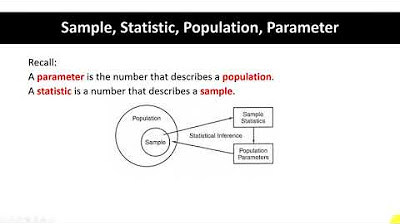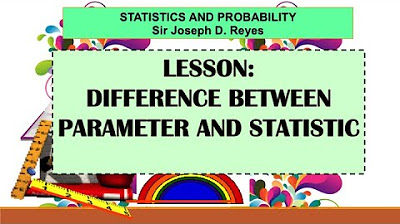Statistics - The vocabulary of statistics
TLDRThis video introduces essential statistical vocabulary, including 'data', 'population', 'sample', 'parameters', 'statistics', and 'variables'. It clarifies the distinction between population (all subjects of interest) and sample (a subset used for study), and explains how parameters describe the population while statistics describe the sample. An example of a study on weight loss in men over 50 on a 'pancake diet' illustrates the application of these terms, highlighting the importance of understanding statistical concepts for data analysis.
Takeaways
- 📊 Data refers to all the information collected during an experiment.
- 🌐 Population is the entire collection of measurements that an analysis aims to study.
- 🔍 A sample is a subset of the population used for practical reasons in a study.
- 🔄 It's common to confuse population and sample, but they represent different groups.
- 📈 Parameters are characteristics of the population, like average weight gain or loss.
- 📊 Statistics are characteristics of the sample, such as the average weight change in the study group.
- 🔑 Variables are characteristics that can vary from one subject to another, like starting weight.
- 👨🦳 The example in the script involves studying the effects of a diet on men over 50.
- 📝 Data collected might include age, weight changes, and subject identifiers.
- 🧐 The goal is to differentiate between the concepts of population, sample, parameter, and statistic.
- 👍 The script aims to clarify these statistical terms with a practical example for better understanding.
Q & A
What is the main focus of the video?
-The main focus of the video is to explain the vocabulary of Statistics, particularly the terms data, population, sample, parameter, statistic, and variable, and to provide an example to illustrate these concepts.
What does the term 'data' refer to in the context of the video?
-In the context of the video, 'data' refers to the information gained from experiments, which is everything collected during the process of conducting an experiment.
How is 'population' defined in the video?
-'Population' is defined as a collection of all the measurements that one is trying to analyze in a study.
What is a 'sample' according to the video?
-A 'sample' is a subset of the population used in a study, representing a smaller portion of the entire group that is being analyzed.
Why is it important to differentiate between 'population' and 'sample'?
-Differentiating between 'population' and 'sample' is important because it helps to understand the scope of the study and the generalizability of the findings; a sample is a part used to infer about the whole population.
What is the difference between a 'parameter' and a 'statistic' in statistics?
-A 'parameter' is a characteristic of the population, while a 'statistic' is a characteristic of the sample. Parameters describe the entire population, whereas statistics describe the sample taken from the population.
What is a 'variable' in the context of statistics?
-A 'variable' is any characteristic whose value may change from one object to another within a population.
What is the example used in the video to illustrate the concepts of data, population, sample, parameter, statistic, and variable?
-The example used in the video is a study to determine if men over 50 can lose weight on the 'pancake diet', where data includes age, weight gain or loss, and subject numbers; the population is all men over 50; the sample is the men participating in the study; parameters might be the average weight change of all men over 50; and the statistic is the average weight change of the sample; variables could include the starting weight of each subject.
Why might one collect data on age, weight gain or loss, and subject number in the given example?
-One might collect data on age, weight gain or loss, and subject number to track the relevant characteristics of the subjects and to monitor changes over the course of the study, as well as to identify and organize the participants.
How does the video suggest one should approach the study of men over 50 and the pancake diet?
-The video suggests that one should approach the study by first defining the population (all men over 50), then selecting a sample from this population to participate in the diet study, and finally analyzing the data collected to determine the effects of the diet on weight change.
What is the purpose of numbering the subjects in the example provided?
-The purpose of numbering the subjects is to keep track of each individual participant in the study, which helps in organizing and analyzing the data collected from each subject.
Outlines
📚 Introduction to Statistical Vocabulary
This paragraph introduces the basic terms of statistics that will be discussed in the video. The speaker aims to make these terms more familiar to the audience. The main terms covered are 'data', 'population', and 'sample'. 'Data' is described as the information collected from experiments, 'population' as the entire set of measurements to be analyzed, and 'sample' as a subset of the population. The speaker promises to clarify these terms with an example at the end of the video.
🔍 Understanding Parameters, Statistics, and Variables
The second paragraph delves deeper into statistical concepts by explaining 'parameters' and 'statistics'. A 'parameter' is defined as a characteristic of the population, while a 'statistic' pertains to a characteristic of the sample. The paragraph also introduces 'variables' as characteristics whose values can vary among subjects within a population. The speaker then provides an example related to a study on weight loss in men over 50 on a specific diet, discussing what constitutes data, population, sample, parameters, statistics, and variables in this context.
Mindmap
Keywords
💡Data
💡Population
💡Sample
💡Parameter
💡Statistic
💡Variables
💡Experiment
💡Measurements
💡Characteristic
💡Pancake Diet
💡Weight Loss
Highlights
Introduction to the vocabulary of Statistics for better understanding of terms in future discussions.
Explanation of 'data' as information gained from experiments.
Definition of 'population' as the complete collection of measurements for analysis.
Clarification of 'sample' as a subset of the population used for study.
Differentiation between 'population' and 'sample' to avoid confusion.
Introduction of 'parameters' as characteristics of the population.
Explanation of 'statistics' as characteristics derived from samples.
Description of 'variables' as characteristics with values that can vary within a population.
Announcement of an example to illustrate the discussed terms.
Hypothetical study on weight loss for men over 50 on a 'pancake diet'.
Collection of data including age, weight change, and subject numbers.
Identification of the population as all men over 50 for the weight loss study.
Selection of a sample from the population for practical study purposes.
Parameters defined as average weight gain or loss for the entire population of men over 50.
Statistics defined as average weight changes within the study's sample.
Variables identified as starting weights which differ among subjects.
Summary of the example to demonstrate the application of data, population, sample, parameters, statistics, and variables.
Conclusion and thanks for watching the tutorial on statistical terms.
Transcripts
Browse More Related Video

Populations, Samples, Parameters, and Statistics

Statistic vs Parameter & Population vs Sample

Statistics: Populations & Samples and Parameters vs Statistics

Symbols commonly used in statistics

Sample, Statistic, Population, Parameter Part 1

DIFFERENCE BETWEEN PARAMETER AND STATISTIC | STATISTICS AND PROBABILITY | TAGLISH
5.0 / 5 (0 votes)
Thanks for rating: